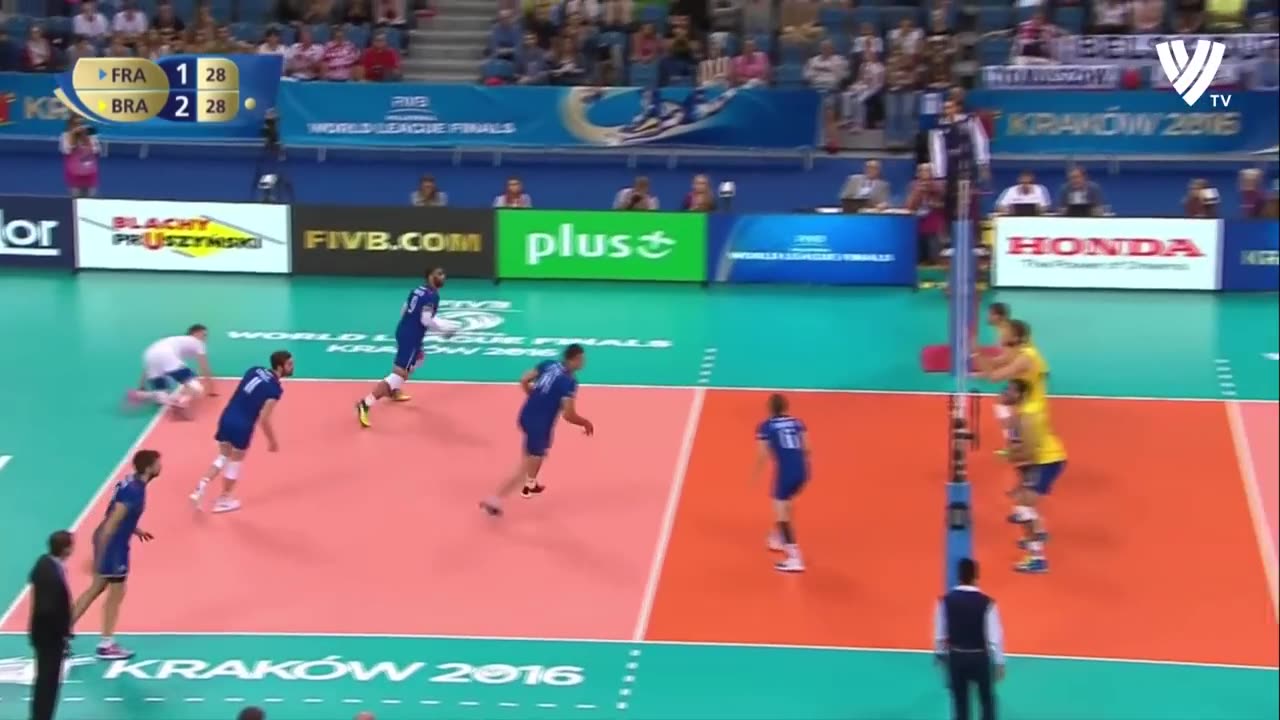Premium Only Content

One of The Craziest Matches in Volleyball History
Volleyball was invented in 1895 by William G. Morgan, physical director of the Young Men’s Christian Association (YMCA) in Holyoke, Massachusetts. It was designed as an indoor sport for businessmen who found the new game of basketball too vigorous. Morgan called the sport “mintonette,” until a professor from Springfield College in Massachusetts noted the volleying nature of play and proposed the name of “volleyball.” The original rules were written by Morgan and printed in the first edition of the Official Handbook of the Athletic League of the Young Men’s Christian Associations of North America (1897). The game soon proved to have wide appeal for both sexes in schools, playgrounds, the armed forces, and other organizations in the United States, and it was subsequently introduced to other countries.
In 1916 rules were issued jointly by the YMCA and the National Collegiate Athletic Association (NCAA). The first nationwide tournament in the United States was conducted by the National YMCA Physical Education Committee in New York City in 1922. The United States Volleyball Association (USVBA) was formed in 1928 and recognized as the rules-making, governing body in the United States. From 1928 the USVBA—now known as USA Volleyball (USAV)—has conducted annual national men’s and senior men’s (age 35 and older) volleyball championships, except during 1944 and 1945. Its women’s division was started in 1949, and a senior women’s division (age 30 and older) was added in 1977. Other national events in the United States are conducted by member groups of the USAV such as the YMCA and the NCAA.
Volleyball was introduced into Europe by American troops during World War I, when national organizations were formed. The Fédération Internationale de Volley Ball (FIVB) was organized in Paris in 1947 and moved to Lausanne, Switzerland, in 1984. The USVBA was one of the 13 charter members of the FIVB, whose membership grew to more than 210 member countries by the late 20th century.
Volleyball match
Britannica Quiz
Sports Fun Facts Quiz
International volleyball competition began in 1913 with the first Far East Games, in Manila. During the early 1900s and continuing until after World War II, volleyball in Asia was played on a larger court, with a lower net, and nine players on a team.
The FIVB-sponsored world volleyball championships (for men only in 1949; for both men and women in 1952 and succeeding years) led to acceptance of standardized playing rules and officiating. Volleyball became an Olympic sport for both men and women at the 1964 Olympic Games in Tokyo.
Get a Britannica Premium subscription and gain access to exclusive content.
European championships were long dominated by Czechoslovakian, Hungarian, Polish, Bulgarian, Romanian, and Soviet (later, Russian) teams. At the world and Olympic level, Soviet teams have won more titles, both men’s and women’s, than those of any other nation. Their success was attributed to widespread grassroots interest and well-organized play and instruction at all levels of skill. A highly publicized Japanese women’s team, Olympic champions in 1964, reflected the interest of private industry in sport. Young women working for the sponsoring company devoted their free time to conditioning, team practice, and competition under expert and demanding coaching. Encouraged by the Japanese Volleyball Association, this women’s team made its mark in international competition, winning the World Championship in 1962, 1966, and 1967, in addition to the 1964 Olympics. At the end of the 20th century, however, the Cuban women’s team dominated both the World Championships and the Olympics.
The Pan American Games (involving South, Central, and North America) added volleyball in 1955, and Brazil, Mexico, Canada, Cuba, and the United States are frequent contenders for top honours. In Asia, China, Japan, and Korea dominate competition. Volleyball, especially beach volleyball, is played in Australia, New Zealand, and throughout the South Pacific.
A four-year cycle of international volleyball events, recommended by the FIVB, began in 1969 with World Cup championships, to be held in the year following the Olympic Games; the second year is the World Championships; in the third the regional events are held (e.g., European championships, Asian Games, African Games, Pan American Games); and in the fourth year the Olympic Games.
Know about the rules and tricks of playing beach volleyball
Know about the rules and tricks of playing beach volleyballSee all videos for this article
beach volleyball
beach volleyball
Beach volleyball—usually played, as its name implies, on a sand court with two players per team—was introduced in California in 1930. The first official beach volleyball tournament was held in 1948 at Will Rogers State Beach, in Santa Monica, California, and the first FIVB-sanctioned world championship was held in 1986 at Rio de Janeiro. Beach volleyball was added to the roster of the 1996 Olympic Games in Atlanta, Georgia.
The game
Observe the psychomotor coordination required to successfully execute a jump serve in volleyball
Observe the psychomotor coordination required to successfully execute a jump serve in volleyballSee all videos for this article
Study the psychomotor coordination required to execute a forearm pass from the basic defensive position
Study the psychomotor coordination required to execute a forearm pass from the basic defensive positionSee all videos for this article
Study the elbows-out, hands-over-head form of the volleyball athlete performing a set pass
Study the elbows-out, hands-over-head form of the volleyball athlete performing a set passSee all videos for this article
Observe a volleyball defender jumping with both hands extended to block a presumed attacker's volley
Observe a volleyball defender jumping with both hands extended to block a presumed attacker's volleySee all videos for this article
Observe the athletic coordination and flexibility required of a volleyball player to perform a defensive dig
Observe the athletic coordination and flexibility required of a volleyball player to perform a defensive digSee all videos for this article
Volleyball requires a minimum of equipment and space and can be played indoors or outdoors. The game is played on a smooth-surfaced court 9 metres (30 feet) wide by 18 metres (60 feet) long, divided by a centre line into two equal areas, one of which is selected by or assigned to each of the two competing teams. Players may not step completely beyond the centre line while the ball is in play. A line 3 metres (10 feet) from and parallel to the centre line of each half of the court indicates the point in front of which a back court player may not drive the ball over the net from a position above the top of the net. (This offensive action, called a spike, or kill, is usually performed most effectively and with greatest power near the net by the forward line of players.) A tightly stretched net is placed across the court exactly above the middle of the centre line; official net heights (measured from the top edge of the net to the playing surface—in the middle of the court) are 2.4 metres (8 feet) for men and 2.2 metres (7.4 feet) for women. Further adjustments in net height can be made for young people and oth
-
 LIVE
LIVE
Kim Iversen
7 hours agoCOVID VACCINE HORROR: Fertility Destroyed & DNA Altered? | Nicolas Hulscher, MPH
2,202 watching -
 LIVE
LIVE
Wayne Allyn Root | WAR Zone
5 hours agoWAR Zone LIVE | 2 SEPTEMBER 2025
41 watching -
 1:51:40
1:51:40
Redacted News
2 hours agoHIGH ALERT! TRUMP IS COMING FOR CHICAGO, U.S. TROOPS PREPARING INVASION TO STOP MURDERS | REDACTED
80.1K87 -
 LIVE
LIVE
Red Pill News
4 hours agoJustice Is Long Dead in The DC Circuit on Red Pill News Live
3,346 watching -
 1:17:50
1:17:50
Awaken With JP
4 hours agoTrans Shooter is the Victim, Vaccines in Trouble, and Greta is Ugly - LIES Ep 106
40.1K16 -
 2:04:31
2:04:31
Pop Culture Crisis
3 hours agoJK Rowling Calls Out HARRY POTTER Director, Sydney Sweeney Dating Scooter Braun? | Ep. 909
17.4K2 -
 1:02:42
1:02:42
Sarah Westall
3 hours agoRemote Viewers: Philadelphia Experiment, Alien Abduction and Future Events w/ the Rabbit Hole Group
4.24K3 -
 56:03
56:03
SGT Report
18 hours agoSILVER'S HISTORIC BREAKOUT -- Chris Marcus
32K10 -
 LIVE
LIVE
LFA TV
11 hours agoLFA TV ALL DAY STREAM - TUESDAY 9/2/25
1,282 watching -
 19:57
19:57
Professor Gerdes Explains 🇺🇦
4 hours agoDecoding Putin's Shanghai Narrative: The Strategic Goal Behind the Lies
3.98K1